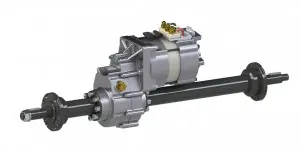What’s the Role of Renewable Energy in Reducing the Environmental Impact of Electric Transaxles?
Introduction
In the global shift towards sustainable transportation, electric transaxles have emerged as a crucial component in the development of electric vehicles (EVs). These transaxles, which combine the functions of a transmission and an axle, are essential for the efficient operation of EVs. However, the environmental benefits of electric transaxles are not limited to their role in vehicles alone. The integration of renewable energy sources in powering these transaxles further amplifies their positive impact on the environment. This article explores the multifaceted role of renewable energy in reducing the environmental impact of electric transaxles, covering technological advancements, economic benefits, and policy implications.
The Environmental Impact of Electric Transaxles
Electric transaxles are designed to enhance the efficiency and performance of electric vehicles. Compared to traditional internal combustion engine (ICE) vehicles, EVs equipped with electric transaxles produce significantly fewer greenhouse gas (GHG) emissions. This reduction is primarily due to the absence of tailpipe emissions and the higher energy conversion efficiency of electric motors. However, the overall environmental impact of electric transaxles also depends on the source of electricity used to charge the vehicles. When renewable energy sources such as solar, wind, and hydropower are used for charging, the carbon footprint of electric transaxles is further minimized.
Renewable Energy Integration
The integration of renewable energy with electric transaxles is a key strategy in reducing the environmental impact of transportation. Renewable energy sources produce little to no GHG emissions during operation, making them ideal for powering EVs. For instance, wind power generates 97% less CO2 equivalent (CO2e) than gas and 99% less than coal per unit of electricity. Similarly, solar, geothermal, and hydropower also produce significantly lower emissions compared to fossil fuels. By utilizing these clean energy sources, the lifecycle emissions of electric transaxles can be drastically reduced.
Technological Advancements
Several technological advancements have facilitated the integration of renewable energy with electric transaxles. Smart charging systems, for example, optimize the charging process by aligning it with periods of high renewable energy availability. This not only reduces the strain on the grid but also ensures that EVs are charged using the cleanest possible energy. Vehicle-to-grid (V2G) technology further enhances this integration by allowing EVs to feed excess energy back into the grid, thereby improving grid stability and supporting the integration of intermittent renewable energy sources. Additionally, advancements in energy storage systems, such as high-capacity batteries and advanced grid-forming inverters, have made it possible to store and distribute renewable energy more efficiently.
Economic Benefits
The economic benefits of using renewable energy to power electric transaxles are substantial. While the initial investment in renewable energy infrastructure can be high, the long-term savings in fuel and maintenance costs are significant. For instance, the cost of solar photovoltaic (PV) panels has decreased dramatically over the past decade, making solar energy an increasingly affordable option for EV charging. Moreover, the reduced dependency on fossil fuels enhances energy security and reduces the vulnerability to fuel price fluctuations. In the long run, these economic benefits contribute to a more sustainable and resilient transportation system.
Policy Implications
Government policies play a crucial role in promoting the integration of renewable energy with electric transaxles. Renewable energy standards, such as the Renewable Portfolio Standard (RPS), have been effective in increasing the share of renewable energy in the grid. These policies not only reduce GHG emissions but also improve grid reliability and lower electricity costs. In addition, subsidies and incentives for EV adoption and renewable energy installations have further accelerated the transition to sustainable transportation. For example, Indonesia has set ambitious targets for EV adoption and renewable energy integration, aiming to achieve net-zero emissions by 2060. Such policies are essential in driving the widespread adoption of electric transaxles powered by renewable energy.
Case Studies
Several case studies highlight the successful integration of renewable energy with electric transaxles. For instance, ERCOT (Electric Reliability Council of Texas) has effectively integrated high shares of variable renewable energy, particularly wind, into its grid. Key strategies include improved weather forecasting, demand response programs, and expansion of transmission infrastructure. Similarly, Xcel Energy Colorado has successfully integrated significant amounts of wind and solar energy into its system through advanced forecasting systems and flexible generation modifications. These examples demonstrate the feasibility and benefits of integrating renewable energy with electric transaxles on a large scale.
Future Prospects
The future of renewable energy integration with electric transaxles looks promising. Technological advancements in energy storage, smart grids, and V2G systems are expected to further enhance the efficiency and reliability of this integration. Additionally, the increasing adoption of renewable energy sources globally is expected to drive down costs and improve accessibility. By 2030, the share of renewable energy in global energy consumption is projected to rise from 30% to 46%, with solar and wind energy leading the way. This trend will significantly reduce the environmental impact of electric transaxles and contribute to a more sustainable transportation future.
Conclusion
The role of renewable energy in reducing the environmental impact of electric transaxles is multifaceted and significant. By integrating renewable energy sources with electric transaxles, we can achieve substantial reductions in GHG emissions, enhance energy security, and realize long-term economic benefits. Technological advancements, supportive policies, and successful case studies all point towards a future where electric transaxles powered by renewable energy become a cornerstone of sustainable transportation.
Post time: Aug-13-2025


